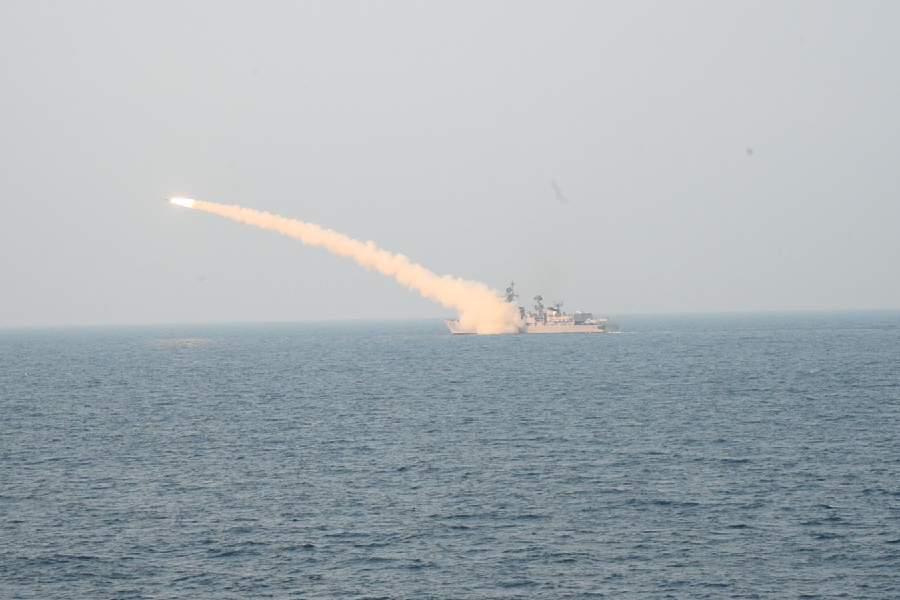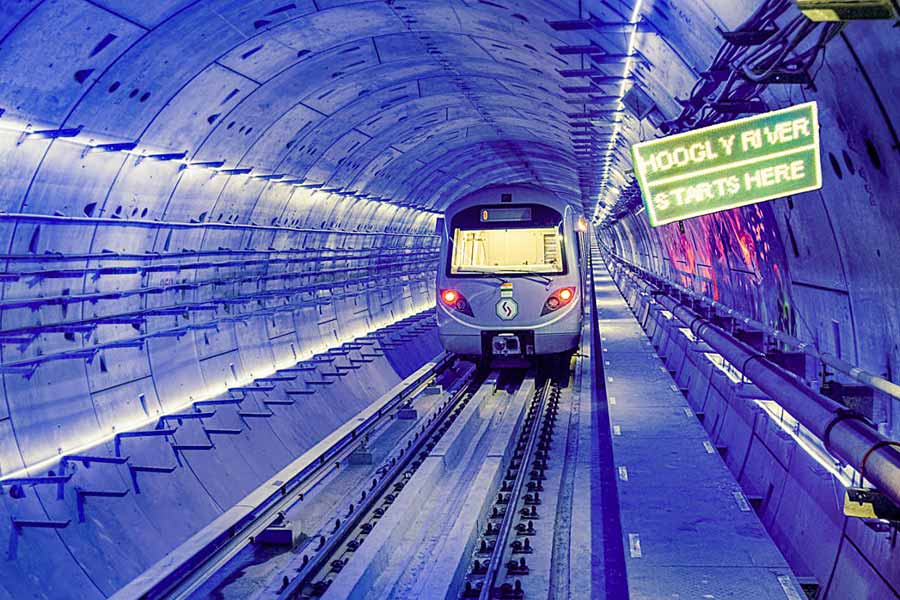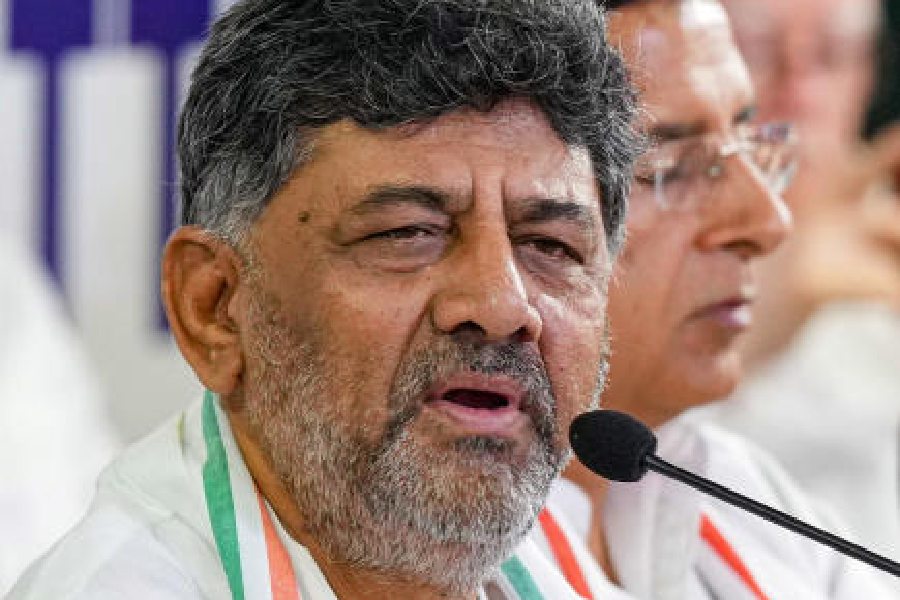 |
| A four-coach Mumbai monorail train chugs back into Wadala car shed after a trip to Chembur. Pictures by Gajanan Dudhalkar |
Mumbai, Feb. 18: Ganapati Bappa Morya — the passengers’ chant was less a cheer and more a prayer as four bubblegum-pink coaches of Mumbai Monorail took off for a test ride on Saturday.
Two years behind schedule and four false starts later, the monorail — touted as India’s first — began a tentative trudge along its single track, at 40kmph running at half its intended speed.
“We have no security clearances to run the train yet. They should come soon. But our engineers say it is safe. Our personnel will be with you on the train though and will share the risk,” a smiling official of the Mumbai Metropolitan Region Development Authority (MMRDA) had announced minutes before boarding.
Children playing cricket on the streets, giggly teenagers on a shanty-terrace and bored shopkeepers jolted out of their afternoon siesta by a train chugging overhead waved enthusiastically.
The train went past dense slums, polluted mangroves that skirt the Mumbai harbour and industrial scrapyards, travelling 8.8km from the eastern suburb of Chembur to Wadala in 25 minutes — about the same time that it takes now by train or road.
This stretch is to open for public use by September. Work on the full 19.54km Chembur-Wadala-Jacob Circle monorail corridor — the first on a list of several proposed corridors, and the second longest in the world after the 23.8km Osaka monorail in Japan — will take a while and is not expected to be complete before next year. Travel time will be shorter once the full stretch, being built at a cost of Rs 2,400 crore, opens and the trains run at 80kmph as planned.
Before the novelty factor wears off, Mumbaikars will hitch a joyride with friends and family. “I will take the kids for a ride when it starts plying but who is going to use this chikni (frothy beauty) for daily commute?” said Anni Kuruvilla, a 41-year-old mother of four.
 |
| A monorail rake parked at the Wadala car shed |
Anni, a day labourer at BP refinery — one of the many that dot the route — shares a 10ftx12ft tenement with another family from her village in Kerala in a Mahul slum near Chembur from where she commutes to work by local train and spends Rs 250 on a monthly pass.
The Monorail tickets will be priced between Rs 8 and Rs 20.
The Chembur-Wadala belt has a massive working class population and, according to the Maharashtra government’s internal findings, 42 per cent people here go to work on foot or bicycles.
Mahul, where Anni lives in a slum adjoining a massive upcoming residential project by DB Realty, was largely a mangrove swamp till a decade and a half ago.
The mangroves are still there but waste from largescale building construction is choking them up. The state government plans to develop the area into a new-age corporate district in the future and builders and developers are branding the Chembur-Wadala stretch the new Cuffe Parade.
“In 10 years, after the trans-harbour link connects Mumbai to Navi Mumbai and when the new airport comes up in Navi Mumbai, the Wadala-Chembur area will develop as a major corporate hub and one of the most sought-after residential areas for the upwardly mobile. The monorail will cater to them. It is a service planned with an eye on the future,” an MMRDA official said.
At present, middle-class residents of neighbourhoods on the Chembur-Wadala line would not see it as a daily travel option because the route is far away from any business district.
“For cities that have a population of less than three million, monorail is the ideal mode of transport. For denser cities, monorail can ideally serve as the feeder line that brings passengers in and takes them out of the Metro network,” acknowledges an official of the Malaysian company Scomi International, which will run the Mumbai monorail on build-operate-transfer basis.
Urban planner Ashwin Wagle says the monorail will face a stumbling block in time- and cost-conscious Mumbai as it has not worked out access- and fare-integration with the suburban rail network that is the lifeline of the city.
“Although located near the suburban rail stations, the connectivity is not seamless. Also, there has been no provision made for fare-integration and passengers will have to buy a separate ticket to board the suburban rail. In the first monorail sector, the monorail will not take the commuter to work — they still have to take the local trains to get to work,” he said.
Back in Malaysia, Scomi’s Kuala Lumpur Monorail went bankrupt in 2007 and the Malaysian government had to bail it out.
The Mumbai monorail is a four-car train with a capacity of 140 passengers per car. For a start, MMRDA will use four trains for the Chembur-Wadala section and expects to ferry 50,000-60,000 passengers a day. Once the full stretch up to Jacob Circle — about 2km from Mumbai Central railway station — is operational, an estimated 1.5 lakh passengers will travel daily.
The service may yet turn out to be for Mumbai what the metro is for Calcutta, but it will miss hitting the record books as India’ s first monorail service.
A century ago, one ran in Patiala and another in Kerala. The Kundala Valley Railway was built in 1902 and operated between Munnar and Top Station, a tourist destination on Kerala-Tamil Nadu border, to transport tea and other goods.
The Patiala State Monorail Trainways was longer than Mumbai’s new-age monorail and covered a 50-mile network. It ran for 17 years between 1910 and 1927 and the train is now housed at the rail museum in New Delhi.
But Mumbai can still claim it as its own — all the major components of the Patiala Monorail were made in Mazgaon, Mumbai, by a British manufacturer.










